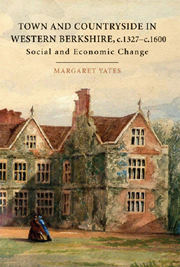Book contents
- Frontmatter
- Contents
- List of tables, figures, and maps
- Acknowledgements
- Abbreviations
- Sums of money
- 1 The end of the Middle Ages?
- 2 Landscapes, population and wealth in western Berkshire from the fourteenth to the sixteenth century
- 3 Town and country relations: Newbury and its hinterland
- 4 Estate management and profitability
- 5 Tenant society
- 6 Conclusion: the chronology of change
- Appendices
- Bibliography
- Index
2 - Landscapes, population and wealth in western Berkshire from the fourteenth to the sixteenth century
Published online by Cambridge University Press: 05 February 2013
- Frontmatter
- Contents
- List of tables, figures, and maps
- Acknowledgements
- Abbreviations
- Sums of money
- 1 The end of the Middle Ages?
- 2 Landscapes, population and wealth in western Berkshire from the fourteenth to the sixteenth century
- 3 Town and country relations: Newbury and its hinterland
- 4 Estate management and profitability
- 5 Tenant society
- 6 Conclusion: the chronology of change
- Appendices
- Bibliography
- Index
Summary
Introduction
It is worth stating again that the different landscapes, economies and societies of the regions of rural England affected the pace of change in their various localities. The pre-modern rural economy was heavily influenced by the geological and topographical structure of its regions. Whether we divide England into highland and lowland regions, or into champion and woodland areas, or by dispersed and nucleated settlement patterns, the regional differences across the country are clear. It is widely accepted that these underlying features account for one of the most fundamental explanations for regional variations in the economy. How landscape shaped the local economy in the pre-industrial period is an important factor in explaining past economies and has been described in detail by other historians and geographers. What is less widely discussed, particularly for the late medieval period, is how the different societies within these regions varied, and in turn had an impact on the shape of change in the locality. It is the purpose of this chapter to describe the landscape and rural economies of western Berkshire, and then to chart shifts in the distribution of population and wealth between the fourteenth and sixteenth centuries. This will reveal broad patterns of both continuity and change, whilst explaining these differences will be the purpose of the following three chapters.
- Type
- Chapter
- Information
- Town and Countryside in Western Berkshire, c.1327–c.1600Social and Economic Change, pp. 24 - 66Publisher: Boydell & BrewerPrint publication year: 2007

